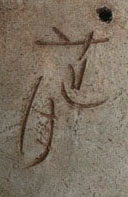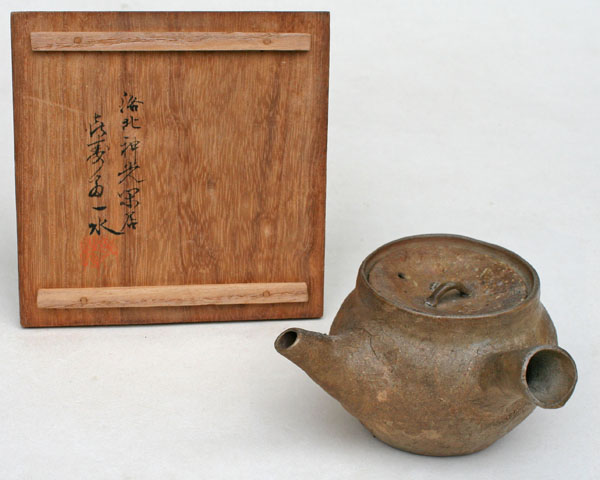Waka/Kyôyaki
Kyûsu, side-handled teapot: Mori hototogisu - The voice of the cuckooSigned: Rengetsu
Seals:
Technique: hand-shaped inside glazed Kyôyaki with a bronze like skin incised with her waka Ø 7,5 x 5,5
Box: authorized in 1939 by Issui (1863-1945)
Condition: very good
The waka reads: 夜をのこすけしきのもりの時鳥青葉がくれのつゆに啼くなり。
Yo o nokosu /keshiki no mori no / hototogisu / aobagakure no / tsuyu ni naku nari. (Ama no karumo, natsu # 12)
The night lingers...
In the lovely forest
The voice of the cuckoo
Cloaked in green leaves
And mist…”
(translation J.Stevens, Lotus Moon, Weatherhill 1994 p. 42).
Rengetsu is one of those extraordinary figures in Japanese art history, one of a kind.
Rengetsu was born in Kyoto. Within a few days after her birth the Õtagaki family adopted her. In 1798 she moved to Kameoka castle to serve the Matsudaira family. Here she studied the woman’s pursuits such as poetry and calligraphy, but she received training in martial arts as well. In 1807 she returned to her family in Kyoto where she married her adopted brother, a young samurai called Mochihisa. In the eight years of her marriage she gave birth to three children, who all died shortly after their birth. In 1815 she divorced her husband, who was to die shortly after. She remarried but already in 1823 her second husband died. She cut her hair and became a nun and took the name Rengetsu, Lotus moon.
With her daughter from her second marriage and her stepfather she moved into a small building on the grounds of the Chion-in. Two years later her daughter died. Without means of support she moved to Okazaki in the Kyoto area together with many artists, where she produced pottery and studied Shijô painting with Matsumura Keibun (1779-1843). She fell in love with Keibun and they lived together. She intensively studied waka. In spite of being a nun, men made advances to her, but not being interested, she pulled out her teeth to look less attractive and to strengthen her inner self. Her pottery became such a big success that she escaped her customers many times and moved more than thirty times, even thirteen times in one year.
She became close friends with Tessai and even tried to adopt him as a son. For the last 25 years of her life he helped and accompanied her. On the invitation of the Abbot Wada Gozan (Gesshin) (1800-1870) she spent her last years in a tea hut on the grounds of the Shinko-in temple where she deeply immersed herself in the study of Buddhism but she also continued her artistic occupations.
Reference:
Canberra 2007
Roberts p. 129
Fister '88 pp. 144-159 (# 69-76)
Price: ON REQUEST

